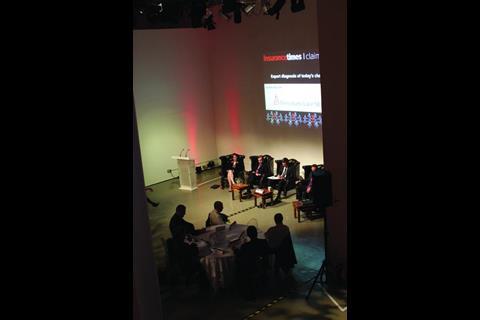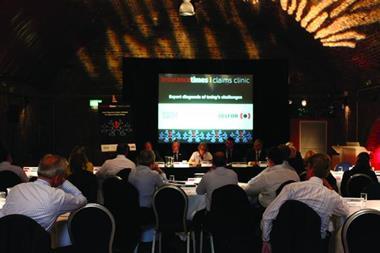AXA’s exit from the GTA has put the claims framework on shaky ground, and the situation between credit hire firms and insurers is at crunch point. Panellists at Insurance Times’s latest claims clinic agree that clear direction is needed
AXA’s recent withdrawal from the General Trade Agreement (GTA) – the framework for the settlement of credit hire claims – has fuelled widespread speculation that more insurers are set to follow. This has put a question mark over the future of the GTA and the direction of the credit hire market.
Held in Vinopolis in London, Insurance Times’s latest claims clinic tackled the contentious issue of credit hire, with panellists representing the views of insurers, credit hire operators (CHOs) and the legal sector on a market that is estimated to cost the insurance industry £500m per year.
National Association of Credit Hire Operators (NACHO) vice-chairman and Vision managing director Tony Copeland was the first to enter the fray. He believed many challenges lay ahead when it came to forging good relationships between insurers and CHOs, but added that a compromise could be found within the guidelines of the GTA.
“In terms of future objectives, we want to embrace recent changes and to utilise our representation in the GTA joint technical committee, to make sure the GTA continues to work and ensure that neither insurers nor CHOs feel they have reason to leave the GTA because of its insufficiency.”
But he conceded there were a number of CHOs that have also failed to act appropriately. “We want to do whatever possible to ensure our members adhere to the GTA process. This is where communication between insurers and NACHO is very important.”
Copeland added: “Insurers have certainly not helped the situation and arguably have fuelled the fire by negotiating the high level of referral fees they benefit from. But equally some CHOs have not helped the cause either."
AXA’s claims director David Williams conceded that insurers were partly to blame for allowing the credit hire saga to escalate over the last decade. “There was a gap in the market and CHOs stepped into that market,” he said.
But he added that costs had reached ridiculous proportions and “they were bordering on illegal”. He said the situation surrounding credit hire was as problematic as fraud. “I’m not saying it is fraud, although there are elements of fraud there.”
Courting confusion
Meanwhile, law firm Berrymans Lace Mawer associate Sarah Cartlidge said the number of litigation cases in credit hire was soaring. “Three years ago, you would not have specialised credit hire departments within most defendant firms. It would be part and parcel of the normal workload, whereas now defendant hire firms have specialised departments to deal with the volume of litigation.”
She added that there was a lack of legal clarity on the issue. “There are certain areas where the courts have not given clear guidance on their expectations.” As a result, insurers and CHOs had different expectations of what was recoverable. The main confusion surrounded the period of hire and what rate of hire could be recovered. “From the litigation side of things, you are getting inconsistencies from the court … the time is ripe for some guidance to help with that interpretation.”
Williams thought the situation has unfairly affected policyholders. “The man in the street is subject to increased premium,” he said, adding that this was behind AXA’s decision to withdraw from the GTA. “We think the GTA encourages practices that are not sufficient and rates that are far too expensive. So we think by exiting from the GTA we can make alternative arrangements. Hopefully, we can come up with a solution that is much more efficient and of greater benefit to the customer.”
He added that many insurers were reluctant to withdraw from the GTA because they wanted to avoid the costs of additional administration. “You shouldn’t stay within a framework just because you don’t want to deal with extra paperwork,” he said. “A lot of comments from insurers seem to suggest to me that they are not in a position to withdraw, but many of them would like to.”
He said it was possible to negotiate better terms and processes outside of the GTA. “There are a number of right-minded CHOs that recognise the limitations of the GTA, are prepared to have separate discreet conversations about what they want and what they can produce, and the timescale. There is no need for the administrative burden to be increased.”
Clean up
Accident Exchange chief executive Steve Evans was critical of AXA’s decision. “You are only able to fix from within, not from without,” he said. “The costs associated with credit hire claims and the different strategic positioning of individual insurers makes it difficult to see the GTA providing a ‘one size fits all’ solution to the industry cost issues.
“But I would argue that it was never meant to provide that solution. It does, however, provide a framework that provides certainty for as many as 60% of claims processed in the spirit of the protocol. With a cost to the insurance industry of £500m annually, delivering that certainty in terms of costs and process has to be beneficial to the entire supply chain.”
Copeland believed the appointment of an independent chairman of the GTA would be a substantial step forward when it came to resolving existing disputes. “It has been agreed that an independent chairperson be recruited to head up the process of tidying up the GTA governance, which will be very interesting,” he said.
Cartlidge said that problems arose from the informal nature of the agreement, however. “It is a gentleman’s agreement. It is not binding legislation. It is, by its very nature, informal and on that basis it is never going to have teeth… Only time will tell if an independent chairman will be able to deal with the volume. If they get it right, it is hopefully a good step forward.”
Williams was less convinced. “They are still not clear at all about what powers the independent chairman is going to have. If your disciplinary process has no teeth, what difference is it going to make?” He added: “The way the GTA currently works you can choose to pull claims in and out. If somebody thinks they’re going to get criticism from the chairman, they can just withdraw.”
The question arose over whether capping rates might be an effective solution. But Cartlidge said this would be difficult to achieve. “The commercial reality is that it would be difficult for them to agree a cap. Effectively, you have a fixed agreement because you have the GTA – and the GTA fixed the rates. It would be difficult for the hire company and insurance to agree a fixed tariff.”
Crazy prices
But Williams believed there was scope for more guidelines on rates. “There are some ridiculous fees charged. I think there could be some general rules. It does seem complete madness that you regularly see credit hire bills that outstrip the value of the vehicle that is damaged. It is more difficult than agreeing a fixed price for rental.”
He said that it was unlikely AXA would rejoin the GTA in the foreseeable future. “We are looking to do things outside of the GTA. It took us a long time to come to the conclusion that we did need to abandon a longstanding market arrangement, so it is not something we are likely to do a U-turn on in a short period of time.”
Evans believed that more dialogue was needed between insurers and CHOs. “Every stakeholder in the process appears to be seeking change and improvements to a mechanism which is, at times, dysfunctional when viewed as a solution between individual stakeholders against their respective strategic aims,” he said.
“The challenge for me, therefore, has to be to create wider and more involved debate from all sides of the industry in order to retain the foundations of the system currently regularising the supply chain. This while still allowing a wider dialogue to extend the benefits and help adjust them to the evolving commercial landscape and also to encourage individual dialogues to build on the GTA to satisfy their own aspirations.” IT

























































No comments yet